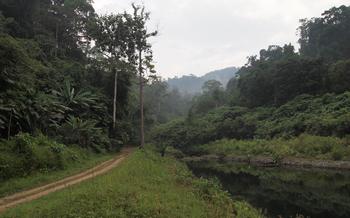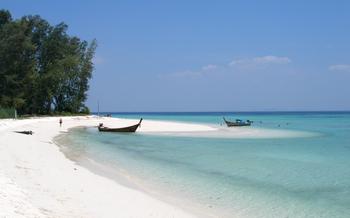
Paya Teng Wildlife Sanctuary
- Paya Teng Wildlife Sanctuary: An Oasis of Biodiversity
- Exploring the Sanctuary's Diverse Habitats
- Encountering Paya Teng's Endemic Species
- Witnessing the Spectacular Birdlife
- Discovering the Marine Treasures
- Embarking on a Wildlife Safari
- Kayaking Through the Mangroves
- Discovering Hidden Beaches and Islands
- Experiencing Local Culture and Traditions
- Camping Under the Stars
- Hiking Trails for Nature Enthusiasts
- Volunteering and Conservation Opportunities
- Supporting Sustainable Tourism Initiatives
- Planning Your Trip to Paya Teng
- Insider Tip: Unforgettable Sunset Views
Paya Teng Wildlife Sanctuary: An Oasis of Biodiversity
Nestled in the heart of Satun Province, Thailand, the Paya Teng Wildlife Sanctuary emerges as a haven for biodiversity, encompassing a diverse range of ecosystems and providing refuge to a multitude of endangered and remarkable species. Established in 1992, this 150-square-kilometer sanctuary has been at the forefront of conservation efforts, protecting the delicate balance of nature within its lush embrace.
Paya Teng's strategic location along the Andaman Sea coast and its unique topography, characterized by towering limestone karsts, mangrove forests, mudflats, and coastal ecosystems, contribute to its exceptional ecological significance. As a critical habitat for numerous endangered species, including the iconic dugong (sea cow) and the elusive Irrawaddy dolphin, the sanctuary serves as their last stronghold, offering a sanctuary for these gentle giants to thrive.
Exploring the Sanctuary's Diverse Habitats
Paya Teng Wildlife Sanctuary boasts a rich mosaic of diverse habitats, each teeming with unique flora and fauna. Venture into the sanctuary's lush tropical rainforests, where towering trees form a verdant canopy overhead, creating a haven for a symphony of wildlife. Discover the intricate world of mangrove forests, where gnarled roots intertwine above the brackish waters, providing shelter and sustenance to a myriad of marine creatures. Explore the vast mudflats, where migratory birds congregate in breathtaking numbers, creating a spectacle that will leave you spellbound. Finally, immerse yourself in the vibrant coastal ecosystems, where pristine beaches, coral reefs, and seagrass beds converge, showcasing the incredible biodiversity of this sanctuary.
Encountering Paya Teng's Endemic Species
Paya Teng Wildlife Sanctuary stands out for its rich biodiversity, home to an array of endemic and endangered species that thrive within its diverse habitats. Among these remarkable creatures are the dugong (sea cow), a gentle marine mammal that inhabits the coastal waters and seagrass beds. With its unique appearance and grazing habits, the dugong holds a special place in the hearts of visitors. Another iconic species is the Irrawaddy dolphin, known for its distinctive rounded forehead and playful nature. These dolphins can be spotted frolicking in the sanctuary's rivers and estuaries. Adding to the park's mammalian diversity is the Oriental white-bellied squirrel, a tree-dwelling species endemic to Southeast Asia. With its striking black and white markings, this squirrel is a delightful sight to behold. Finally, Paya Teng is home to the mangrove pit viper, a venomous snake that plays a crucial role in maintaining the ecological balance of the mangrove ecosystem. Its presence serves as a reminder of the delicate interdependence within the sanctuary's diverse habitats.
Witnessing the Spectacular Birdlife
Paya Teng Wildlife Sanctuary is a haven for bird enthusiasts, offering an extraordinary diversity of avian species. The sanctuary's unique habitats, from dense rainforests to coastal wetlands, provide ideal conditions for a wide range of birds to thrive.
Migratory birds, such as the majestic Brahminy kite, the graceful Oriental darter, and the colorful Asian paradise-flycatcher, flock to Paya Teng during the winter months, escaping the harsh conditions of their northern breeding grounds. The sanctuary's mudflats and mangrove forests are particularly attractive to these long-distance travelers, offering abundant food and shelter.
Resident bird species, such as the vibrant blue-throated bee-eater, the comical hornbill, and the elusive white-rumped shama, call Paya Teng home year-round. These birds can be spotted foraging in the forests, nesting in the mangroves, or soaring over the coastal waters.
For birdwatchers, Paya Teng offers a variety of prime spots to observe these feathered wonders. The elevated birdwatching tower near the sanctuary's headquarters provides panoramic views of the surrounding habitats, allowing visitors to scan the treetops and wetlands for distant birds. The mangrove boardwalk offers a unique perspective, allowing visitors to get up close to these fascinating ecosystems and spot birds that are adapted to this unique environment.
The best time for birdwatching in Paya Teng is during the early morning or late afternoon, when the birds are most active. Visitors should bring binoculars or a spotting scope to enhance their viewing experience and a camera to capture the beauty of these avian treasures.
Discovering the Marine Treasures
Paya Teng Wildlife Sanctuary is home to a mesmerizing array of marine life, concealed beneath the azure waters of the Andaman Sea. The sanctuary encompasses pristine coral reefs, vibrant seagrass beds, and a kaleidoscope of marine species.
The coral reefs of Paya Teng are a testament to the sanctuary's flourishing marine ecosystem. These underwater havens teem with colorful corals, anemones, and a myriad of reef fish, creating a mesmerizing spectacle for snorkelers and divers. The intricate coral formations provide shelter and sustenance for a diverse array of marine life, contributing to the sanctuary's ecological richness.
Seagrass beds, with their swaying green blades, form another vital habitat within the sanctuary. These underwater meadows serve as a nursery for juvenile fish and provide sustenance for marine herbivores such as dugongs and sea turtles. The intricate root systems of seagrass beds also help to stabilize the seabed and prevent erosion, contributing to the overall health of the marine environment.
The marine life diversity of Paya Teng is truly astounding. The sanctuary's waters are home to a multitude of fish species, including clownfish, parrotfish, angelfish, and the majestic manta ray. Dolphins and whales are also known to frequent the area, captivating visitors with their playful antics and awe-inspiring presence.
Snorkeling and diving enthusiasts will find Paya Teng to be a paradise. The crystal-clear waters offer excellent visibility, allowing visitors to explore the vibrant underwater world with ease. Numerous snorkeling and diving sites are scattered throughout the sanctuary, catering to different skill levels and interests. Whether you're a beginner seeking a gentle introduction to the marine realm or an experienced diver eager to explore deeper waters, Paya Teng has something to offer everyone.
Embarking on a Wildlife Safari
Paya Teng Wildlife Sanctuary offers an unforgettable experience for wildlife enthusiasts, providing the opportunity to embark on guided wildlife safaris that delve deep into the heart of the sanctuary's diverse ecosystems. These safaris are led by experienced guides who possess an extensive knowledge of the local flora and fauna, ensuring a safe and enriching experience for visitors.
Best Time for Wildlife Sightings: The best time to witness the sanctuary's wildlife in all its glory is during the dry season, which runs from November to April. During this period, the water levels recede, creating ideal conditions for spotting animals that congregate near water sources. The cooler temperatures also make it more comfortable for exploring the sanctuary's trails and waterways.
Ethical Wildlife Viewing Practices: When embarking on a wildlife safari in Paya Teng, it is essential to adhere to ethical wildlife viewing practices. This includes maintaining a respectful distance from animals, avoiding disturbing their natural behavior, and using binoculars or telephoto lenses for photography. Visitors should also be mindful of noise levels and refrain from using flash photography, as these can startle or disturb wildlife.
Safari Routes and Trails: The sanctuary offers a variety of safari routes and trails catering to different interests and fitness levels. Visitors can choose from leisurely walks along the forest trails, where they can spot birds, reptiles, and small mammals, to more adventurous hikes that lead to hidden waterfalls and viewpoints. For those seeking a truly immersive experience, overnight safaris are also available, allowing visitors to camp under the stars and witness the nocturnal wonders of the sanctuary.
Kayaking Through the Mangroves
Glide through the tranquil waters of Paya Teng's mangrove forests, immersing yourself in the symphony of nature. Explore the intricate network of waterways, lined with lush vegetation and teeming with diverse wildlife. Discover hidden coves, encounter exotic birds, and witness the mesmerizing dance of marine creatures.
Join a guided kayaking tour to learn about the unique ecosystem and its inhabitants. Expert guides will lead you through the mangroves, sharing insights into the delicate balance of life in this remarkable habitat. Paddle at your own pace, taking in the tranquility and beauty of the surroundings.
For a truly immersive experience, consider kayaking during the early morning or late afternoon, when the light casts a golden glow on the mangroves. As the sun sets, the sky transforms into a canvas of vibrant colors, creating a magical atmosphere.
Remember to bring your camera to capture the stunning scenery and wildlife encounters. Be mindful of the mangrove ecosystem and its inhabitants, maintaining a respectful distance and avoiding disturbing the delicate balance.
Whether you're a seasoned kayaker or a novice adventurer, paddling through Paya Teng's mangroves promises an unforgettable experience, connecting you with the wonders of nature and leaving you with lasting memories.
Discovering Hidden Beaches and Islands
Tucked away within the Paya Teng Wildlife Sanctuary are hidden gems waiting to be discovered – secluded beaches with pristine sands, uninhabited islands teeming with wildlife, and marine parks that showcase the beauty of the underwater world.
Ko Phetra: Embark on a boat trip to Ko Phetra, a small island known for its tranquil atmosphere and crystal-clear waters. Spend the day swimming, sunbathing, or exploring the island's lush interior.
Ko Hin Ngam: This uninhabited island boasts stunning coral reefs, making it a paradise for snorkelers and divers. Dive into the vibrant marine life, where you can encounter colorful fish, sea turtles, and even the occasional dolphin.
Than Sadet-Ko Pha-ngan National Park: Explore the wonders of this marine park, which encompasses several islands, including Ko Pha-ngan. Discover secluded beaches, go snorkeling or diving in the coral-rich waters, and encounter diverse marine life, including sea turtles and dolphins.
Island Hopping Tours: Join an organized island-hopping tour to visit multiple islands in the sanctuary. These tours typically include snorkeling stops, beach visits, and opportunities to explore the unique ecosystems of each island.
Experiencing Local Culture and Traditions
Nestled within the Paya Teng Wildlife Sanctuary are several villages that offer a glimpse into the vibrant local culture and traditions. Visitors can interact with the friendly villagers, who are proud to share their way of life. Cultural performances and festivals are often held, showcasing traditional music, dance, and handicrafts. Indulge in the delicious local cuisine, which features fresh seafood, tropical fruits, and fragrant herbs. Homestay programs provide an immersive experience, allowing visitors to stay with local families, learn about their daily lives, and contribute to the community.
Camping Under the Stars
For those seeking a truly immersive experience, camping amidst the tranquil surroundings of Paya Teng Wildlife Sanctuary is an unforgettable adventure. Designated camping areas, equipped with basic facilities like restrooms and picnic tables, offer a rustic retreat for nature enthusiasts. Pitch your tent under the canopy of stars and awaken to the symphony of birdsong and the gentle rustling of leaves. Embrace the simplicity of life as you reconnect with nature and enjoy the serenity of the wilderness.
Ensure your safety by adhering to the established guidelines and regulations. Campfires are generally prohibited to minimize the risk of forest fires. Embrace the darkness and utilize flashlights or headlamps for nighttime navigation. Respect the wildlife by maintaining a safe distance and avoiding any interactions.
Elevate your camping experience by packing essential items such as a sleeping bag, flashlight, insect repellent, and a first-aid kit. Consider bringing binoculars for wildlife observation and a camera to capture the breathtaking beauty of your surroundings. Embrace the opportunity to disconnect from technology and immerse yourself in the tranquility of the natural world.
Hiking Trails for Nature Enthusiasts
Paya Teng Wildlife Sanctuary offers a network of well-maintained hiking trails that cater to nature enthusiasts of all levels. These trails wind through diverse habitats, providing breathtaking views and opportunities to encounter wildlife up close.
The beginner-friendly trails are ideal for families and casual hikers, offering gentle slopes and scenic vistas. These trails lead to picturesque waterfalls, where visitors can take a refreshing dip or simply relax and soak in the tranquil atmosphere.
For more experienced hikers, challenging trails venture into the heart of the rainforest, where towering trees and dense vegetation create a sense of awe and wonder. These trails offer opportunities to spot rare and elusive wildlife, including gibbons swinging through the canopy and hornbills soaring overhead.
Along the way, hikers can marvel at the sanctuary's unique flora, including towering dipterocarp trees, delicate orchids, and carnivorous pitcher plants. The trails are also dotted with informative signage, providing insights into the sanctuary's ecology and conservation efforts.
To ensure a safe and enjoyable hiking experience, visitors are advised to wear appropriate footwear and clothing, carry adequate water and snacks, and be aware of the potential for wildlife encounters. Respecting the sanctuary's rules and regulations is essential to minimize disturbances to the delicate ecosystem.
Volunteering and Conservation Opportunities
Paya Teng Wildlife Sanctuary offers unique opportunities for travelers who wish to contribute to conservation efforts and gain hands-on experience in wildlife protection. Volunteer programs and conservation projects are available throughout the year, inviting participants to actively engage in various initiatives.
Volunteers can assist in wildlife monitoring, data collection, habitat restoration, and educational outreach programs. They may have the chance to work alongside researchers, conservationists, and local communities, gaining valuable insights into the challenges and rewards of wildlife conservation.
Some volunteer programs focus on specific species, such as the dugong or the Irrawaddy dolphin, providing opportunities for participants to learn about their behavior, habitat requirements, and conservation status. Others focus on broader conservation issues, such as mangrove restoration or sustainable tourism practices.
By volunteering in Paya Teng Wildlife Sanctuary, travelers can make a meaningful contribution to the protection of this unique and biodiverse ecosystem while gaining a deeper understanding of conservation principles and practices. The experience is both rewarding and educational, offering a unique perspective on the challenges and triumphs of wildlife conservation.
Supporting Sustainable Tourism Initiatives
As a responsible traveler, supporting sustainable tourism initiatives while visiting Paya Teng Wildlife Sanctuary is crucial. Opt for tour operators who prioritize conservation and employ local guides. These guides not only share their expertise but also provide economic opportunities for the community. Choose eco-friendly accommodations that use renewable energy, reduce water consumption, and minimize waste. Minimize your environmental impact by avoiding single-use plastics, conserving water and energy, and respecting the natural habitat. Promote sustainable practices among fellow visitors by raising awareness and encouraging responsible behavior. Remember, your actions can make a significant difference in preserving the sanctuary's pristine beauty for future generations.
Planning Your Trip to Paya Teng
Getting there:
Paya Teng Wildlife Sanctuary is located in the Satun province of Thailand. The nearest major city is Trang, which has an international airport with regular flights from Bangkok and other regional destinations. From Trang, travelers can take a bus or taxi to the town of Satun, and then arrange for a boat transfer to the sanctuary.
Accommodation options:
Within the sanctuary, there are several options for accommodation, including basic guesthouses, bungalows, and camping facilities. For a more comfortable stay, travelers can choose from a range of hotels and resorts located in the nearby town of Satun.
Packing essentials:
When packing for a trip to Paya Teng, it is important to bring comfortable clothing and footwear suitable for outdoor activities. Insect repellent, sunscreen, and a hat are also essential for protection against the sun and insects. For wildlife enthusiasts, binoculars and a camera are highly recommended.
Health and safety precautions:
Paya Teng is a relatively safe destination, but it is important to take precautions against certain health risks. Malaria is present in the area, so travelers should consult with their doctor about taking antimalarial medication. It is also advisable to drink bottled water and avoid eating raw or undercooked food.
Insider Tip: Unforgettable Sunset Views
The Paya Teng Wildlife Sanctuary offers breathtaking sunset views that will leave you mesmerized. Don't miss the opportunity to witness the sky ablaze with vibrant hues as the sun dips below the horizon. For the most unforgettable experience, head to one of the secluded beaches or islands within the sanctuary. Find a spot where you can set up your tripod and capture stunning photographs of the sunset over the tranquil waters. Remember to bring your camera, a sturdy tripod, and a wide-angle lens to capture the vastness of the sky and the surrounding landscape. Combine your sunset viewing with other activities such as kayaking or a leisurely stroll along the beach, making it a truly memorable experience.




